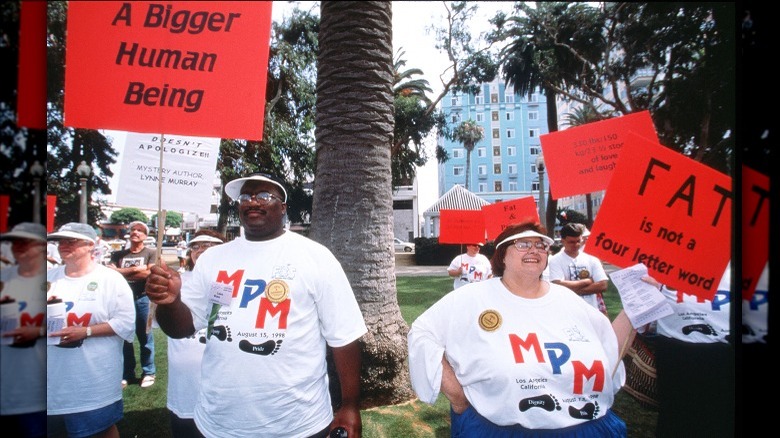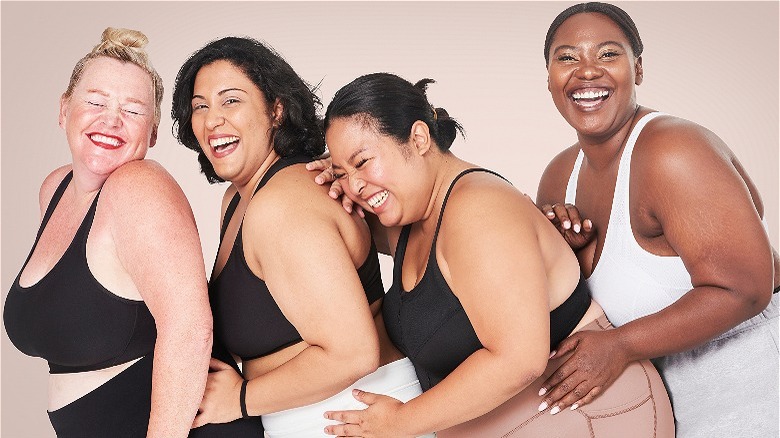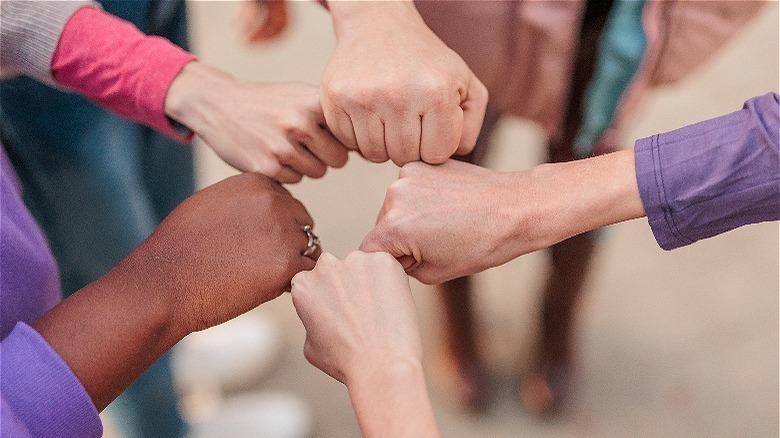The Evolution Of The Body Positivity Movement
Entering the mainstream cultural vernacular in recent years, the idea of "body positivity" has transformed from a niche cause to an all-encompassing movement in which everybody is encouraged to love their bodies just as they are. Of course, this is a powerful and universal practice but, like many terms that stem from highly specific cultural or academic spaces meant to describe a particular idea or phenomenon, such as "empowerment" or "intersectional," the body positivity movement has been co-opted.
First, for commercial purposes, whether it's to sell a product or a brand that often capitalizes on our insecurities. And likewise, by people who have not endured the same level of discrimination because of the size of their bodies as those who spurred the creation of the movement. So, how has the body positivity movement become what it is today? Has it strayed so far from its origins that it has now become meaningless? And, if so, how can the body positivity movement refocus? Let's break it all down.
The origins of the body positivity movement
Standards for "healthy bodies" have changed throughout history but fat people have been consistently discriminated against in a plethora of ways regardless, including through weight bias, which manifests as workplace harassment or being denied a loan and even urgent medical care on the basis of weight, amongst other injustices. Fat people also experience significant stereotyping and stigmatization that can lead to both physical and psychological harm, according to a study published in the Canadian Medical Association Journal.
The term "body positivity" originated around 1967, when hundreds of people staged a sit-in — or rather, a "fat-in" as the Center for Discovery notes — at Central Park to protest widespread discrimination and stigma against fat people. Protestors ate food and burned artifacts of anti-fatness, for example, diet books and photographs of models who were famous for being ultra-thin. Then, in 1969, the National Association to Aid Fat Americans was formed (now the National Association to Advance Fat Acceptance), which treated "discrimination against fat people as a civil rights issue."
As time went on, NAAFA spurred the creation of more radical chapters, including the Fat Underground, which preached "fat liberation" for those who were oppressed due to their race or class in addition to their weight, per Ravishly. As Chelsea Kronengold, manager of communications at the National Eating Disorders Association, informed Refinery29: "The body positive movement was created by and for people in marginalized bodies, particularly fat, Black, queer, and disabled bodies."
Fighting for inclusion
The movement did not always emphasize inclusivity on all fronts, however. According to Tigress Osborn, the chair-elect of the National Association for Fat Acceptance (NAAFA), white protestors believed that Black Americans were more accepting of fat bodies, and therefore "this important movement to help marginalized people, often marginalized whole groups of people itself," as she wrote for the BBC.
While the term "body positivity" was not yet widespread as the fat acceptance movement grew through the decades, the dawn of the internet changed, well, everything. As Osborn writes, "The internet was one of the main places where body shame and body love were spread." And as social media sites rapidly developed, activism for fat acceptance was strengthened online, leading to a strain of digital activism known as "fat visibility."
Because it was safer to experiment with enjoying one's body online than in public, as Osborn pointed out, fat visibility proliferated digitally — though still not without backlash. Influencers and celebrities alike have been shamed for "glorifying obesity." However, a high body mass index (BMI) is not an indication of poor health, and the term "obese," typically used as a medical diagnosis, is now also being debated as a slur.
New generation, new outlook?
Despite what appears to be a growing receptivity to ideas such as "self-love," "self-care," and "body positivity," which abound online in hashtags and infographics, fat acceptance is still a challenge for young people who have grown up with the greater visibility of the internet. In fact, it could be argued that the opposite has occurred. Facebook's own internal findings have shown that Instagram can be damaging to the mental health of teenage girls, for example, by catalyzing eating disorders, as reported by The Wall Street Journal.
Face filters, cosmetic procedures, and exposure to advertising and aspirational messaging just scratch the surface of the unrealistic expectations online media poses to young people struggling with their body image. Vox notes that today's youth are engaged in "body image wars" without having the necessary tools to navigate what that entails. Pascale Saintonge Austin, who directs peer education programming for the nonprofit Children's Aid, argued that "there just needs to be more of a conversation with our young people" about their body image, and how it can be negatively affected by social media.
While plus-size models such as Ashley Graham began to appear on mainstream magazine covers like Sports Illustrated in 2016 — the publication's first-ever plus-size cover star — and clothing brands such as Khloe Kardashian's Good American (which also launched in 2016) began stocking sizes for larger bodies, progress was incremental. To date, the term "body positivity" has now racked up more than 33 billion views on TikTok.
The new reality of the body positivity movement
The term "body positivity" continues to be fought over. Some have expressed their struggle grappling with body positivity while also wanting to lose weight. Others use it on the heels of appropriation, where certain cosmetic procedures mirror the look of Black bodies and features, ignoring the fact that Black women have been mocked for them. Certain people even use it for "small deviations from the stereotypical idea," per Vox. And the correlation between sexual minority youth and weight-based victimization is well-documented, though under-researched.
Cosmetic procedures and the weight loss industry are as profitable as ever, so where does body positivity actually stand in this cultural climate? Michaela Martin wrote for the Ohio State University Wellness Center: "It seems as though society has taken the body positivity movement, originally an absolutely radical rebuke of societal beauty standards, and warped it to still be revolutionary, just not 'too' revolutionary."
The author also suggests that, while thin, white, bodies are not excluded, they should not be the focus. Instead, the author argues, "Going forward, it is vital that when we use the term 'body positivity' we acknowledge and remember the history behind the movement." Further, "We need to continue to advocate for Black voices, queer voices, and fat voices in the movement, and recognize the intersectionality of race, class, gender, sexuality, and weight stigma."
Looking toward the future of body positivity
When the United States Supreme Court overturned Roe V. Wade in 2022, stripping the constitutional right to abortion, concepts including body autonomy and body liberation (which can include fat liberation) became crucial, taking body positivity a step further. Hosts Nikki Snow and Rachael Babiracki discuss the connection between the two in the podcast "PHIT Society," which explores the "human side of fitness, health, and wellness."
"We cannot be liberated as individuals or as a community or as a society if we are controlling other people and what they do with their bodies," co-host Babiracki says. "So leaning into body liberation work, all of these things are connected ... so diet culture is a mode of oppression that is tied to patriarchy that is tied to white supremacy that is tied to capitalism — denying abortion access is tied to the same systems. It's the same three-headed monster causing this."
Babiracki also pointed out that recognizing the relationship between them is important because, by doing so, "We can start to move a strategy that really addresses the roots of the problem." She believes there is, "a lot of optimism and hope in that because if you don't see the connectedness and the relatedness to it, it can start to feel very overwhelming" when you consider just how much is wrong. Thus the way forward is together.





